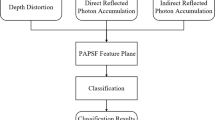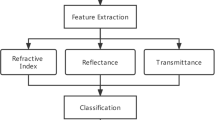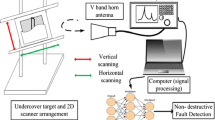Abstract
We propose an innovative method of material classification based on the imaging model of pulsed time-of-flight (ToF) camera integrated with the unique signature that describes physical properties of each material named reflection point spread function (RPSF). First, the optimization method reduces the effect of material surface interreflection, which would affect RPSF and lead to decreased accuracy in classification, by alternating direction method of multipliers (ADMM). A method named feature vector normalization is proposed to extract material RPSF features. Second, according to the nonlinearity of the feature vectors, the structure of hidden layer neurons of radial basis function (RBF) neural network is optimized based on singular value decomposition (SVD) to improve generalization. Finally, the similar appearance of plastics and metals are classified on turntable-based measurement system by own design. The average classification accuracy reaches 93.3%, and the highest classification accuracy reaches 94.6%.




















Similar content being viewed by others
References
Tanaka, K., Mukaigawa, Y., Funatomi, T., Kubo, H., Matsushita, Y., Yagi, Y.: Material classification using frequency-and depth-dependent time-of-flight distortion. In: Proceedings of the IEEE Conference on Computer Vision and Pattern Recognition, pp. 79–88 (2017)
Varma, M., Andrew, Z.: A statistical approach to texture classification from single images. Int. J. Comput. Vis. 62(1–2), 61–81 (2005)
Varma, M., Zisserman, A.: A statistical approach to material classification using image patch exemplars. IEEE Trans. Pattern Anal. Mach. Intell. 31(11), 2032–2047 (2008)
Schwartz, G., Nishino, K.: Visual material traits: Recognizing per-pixel material context. In: Proceedings of the IEEE International Conference on Computer Vision Workshops, pp. 883–890 (2013)
Schwartz, G., Nishino, K.: Automatically discovering local visual material attributes. In: Proceedings of the IEEE Conference on Computer Vision and Pattern Recognition, pp. 3565–3573 (2015)
Salamati, N., Fredembach, C., Süsstrunk, S.: Material classification using color and NIR images. In: Color and Imaging Conference. Society for Imaging Science and Technology, No. 1, pp. 216–222 (2009)
Orun, A.B., Alkis, A.: Material identification by surface reflection analysis in combination with bundle adjustment technique. Pattern Recogn. Lett. 24(9–10), 1589–1598 (2003)
Liu, C., Gu, J.: Discriminative illumination: per-pixel classification of raw materials based on optimal projections of spectral brdf. IEEE Trans. Pattern Anal. Mach. Intell. 36(1), 86–98 (2013)
Wang, O., Gunawardane, P., Scher, S., Davis, J.: Material classification using BRDF slices. In: 2009 IEEE Conference on Computer Vision and Pattern Recognition, pp. 2805–2811 (2009)
Kadambi, A., Whyte, R., Bhandari, A., Streeter, L., Barsi, C., Dorrington, A., Raskar, R.: Coded time of flight cameras: sparse deconvolution to address multipath interference and recover time profiles. ACM Trans. Graph. 32(6), 1–10 (2013)
O’Toole, M., Heide, F., Xiao, L., Hullin, M.B., Heidrich, W., Kutulakos, K.N.: Temporal frequency probing for 5D transient analysis of global light transport. ACM Trans. Graph. 33(4), 1–11 (2014)
Lin, J., Liu, Y., Hullin, M. B., Dai, Q.: Fourier analysis on transient imaging with a multifrequency time-of-flight camera. In: Proceedings of the IEEE Conference on Computer Vision and Pattern Recognition, pp. 3230–3237 (2014)
Kadambi, A., Zhao, H., Shi, B., Raskar, R.: Occluded imaging with time-of-flight sensors. ACM Trans. Graph. 35(2), 1–12 (2016)
Horaud, R., Hansard, M., Evangelidis, G., Ménier, C.: An overview of depth cameras and range scanners based on time-of-flight technologies. Mach. Vis. Appl. 27(7), 1005–1020 (2016)
Su, S., Heide, F., Swanson, R., Klein, J., Callenberg, C., Hullin, M., Heidrich, W.: Material classification using raw time-of-flight measurements. In: Proceedings of the IEEE Conference on Computer Vision and Pattern Recognition, pp. 3503–3511 (2016)
Foix, S., Alenya, G., Torras, C.: Lock-in time-of-flight (ToF) cameras: a survey. IEEE Sens. J. 11(9), 1917–1926 (2011)
Bhandari, A., Raskar, R.: Signal processing for time-of-flight imaging sensors: an introduction to inverse problems in computational 3-D imaging. IEEE Signal Process. Mag. 33(5), 45–58 (2016)
Kajiya, J. T.: The rendering equation. In: Proceedings of the 13th annual conference on Computer graphics and interactive techniques, pp. 143–150 (1986)
Zhang, Z.: A flexible new technique for camera calibration. IEEE Trans. Pattern Anal. Mach. Intell. 22(11), 1330–1334 (2000)
Gabay, D., Mercier, B.: A dual algorithm for the solution of nonlinear variational problems via finite element approximation. Comput. Math Appl. 2(1), 17–40 (1976)
Xiao, L., Heide, F., O’Toole, M., Kolb, A., Hullin, M. B., Kutulakos, K., Heidrich, W.: Defocus deblurring and superresolution for time-of-flight depth cameras. In: Proceedings of the IEEE Conference on Computer Vision and Pattern Recognition, pp. 2376–2384 (2015)
Orr, M. J.: Introduction to radial basis function networks. (1996)
Schilling, R.J., Carroll, J.J., Al-Ajlouni, A.F.: Approximation of nonlinear systems with radial basis function neural networks. IEEE Trans. Neural Netw. 12(1), 1–15 (2001)
Wanas, N., Auda, G., Kamel, M. S., Karray, F.: On the optimal number of hidden nodes in a neural network. In: IEEE Canadian Conference on Electrical and Computer Engineering, Conference Proceedings, Vol. 2, pp. 918–921 (1998)
Braun, J., Griebel, M.: On a constructive proof of Kolmogorov’s superposition theorem. Constr. Approx. 30(3), 653 (2009)
Murata, N., Yoshizawa, S., Amari, S.I.: Network information criterion-determining the number of hidden units for an artificial neural network model. IEEE Trans. Neural Netw. 5(6), 865–872 (1994)
Teoh, E.J., Tan, K.C., Xiang, C.: Estimating the number of hidden neurons in a feedforward network using the singular value decomposition. IEEE Trans. Neural Netw. 17(6), 1623–1629 (2006)
Osborne, B. G.: Near-infrared spectroscopy in food analysis. In: Encyclopedia of analytical chemistry: applications, theory and instrumentation (2006)
Workman Jr., J.J.: Interpretive spectroscopy for near infrared. Appl. Spectrosc. Rev. 31(3), 251–320 (1996)
Erickson, Z., Luskey, N., Chernova, S., Kemp, C.C.: Classification of household materials via spectroscopy. IEEE Robot. Autom. Lett. 4(2), 700–707 (2019)
Dalponte, M., Bruzzone, L., Vescovo, L., Gianelle, D.: The role of spectral resolution and classifier complexity in the analysis of hyperspectral images of forest areas. Remote Sens. Environ. 113(11), 2345–2355 (2009)
Acknowledgements
This work was supported by the National Natural Science Foundation of China (Nos. 41606219, 41776186), the Scientific Research Project of Beijing Educational Committee (No. KM 201910005027) and the Rixin Foundation of Beijing University of Technology. In addition, the author would like to thank the anonymous referee for invaluable comments and suggestions.
Author information
Authors and Affiliations
Corresponding author
Additional information
Publisher's Note
Springer Nature remains neutral with regard to jurisdictional claims in published maps and institutional affiliations.
Rights and permissions
About this article
Cite this article
Lang, S., Zhang, J., Cai, Y. et al. Classification of materials using a pulsed time-of-flight camera. Machine Vision and Applications 32, 30 (2021). https://doi.org/10.1007/s00138-020-01163-5
Received:
Revised:
Accepted:
Published:
DOI: https://doi.org/10.1007/s00138-020-01163-5




